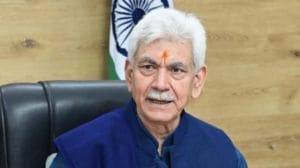Interview: Equity exposure for govt, non-govt employees should be uniform, says PFRDA chairman Hemant Contractor
Hemant Contractor said, "The private sector has grown very well. The All Citizens Scheme has grown by almost 100 per cent. The Atal Pension Scheme has also grown by 100 per cent. We have 60 lakh subscribers in Atal schemes. These schemes are doing well."
 Mandatory annuity is there to the extent of 40 per cent of the corpus of NPS. (Illustration: C R Sasikumar)
Mandatory annuity is there to the extent of 40 per cent of the corpus of NPS. (Illustration: C R Sasikumar)
Hemant Contractor, chairman of the Pension Fund Regulatory and Development Authority (PFRDA), which regulates the National Pension System (NPS) with a corpus of close to Rs 2 lakh crore, says that it has managed to get over 10 per cent returns for its 1.67 crore subscribers in the past 8 years. In an interview with GEORGE MATHEW, Contractor, who was earlier the managing director of State Bank of India (SBI), spoke about the new plans and initiatives of the regulator. Edited excerpts:
What are your plans to expand the pension scheme? Have you worked out the auto-enrolment system?
Auto-enrolment is a concept which is popular in the UK and New Zealand, among other countries. These are voluntary schemes. What happens is that if a sector is covered under auto-enrolment, all the people working in that sector will automatically get covered under the pension scheme unless they chose to opt out. This has been tried out successfully in some countries. We feel that in India also there is a scope. This proposal is now with the government. This is mostly for the unorganised sector.
Are you planning to rework or review mandatory annuity under NPS?
Mandatory annuity is there to the extent of 40 per cent of the corpus of NPS. We have been discussing with the government some alternatives like systematic withdrawal plan. This is still under discussion with the government. We do feel that some choices should be given to the subscribers in addition to annuity.
Is PFRDA working on a plan to provide housing for members?
We had set up a committee. They had sent the final report last week. We will look into that. In many countries, people who join the pension scheme do have the facility of using some of the funds for the housing needs. Even the EPFO (Employees’ Provident Fund Organisation) is doing it.
 Hemant Contractor, chairman of the Pension Fund Regulatory and Development Authority (PFRDA).
Hemant Contractor, chairman of the Pension Fund Regulatory and Development Authority (PFRDA).
What has been the response of the private sector to the pension scheme?
The private sector has grown very well. The All Citizens Scheme has grown by almost 100 per cent. The Atal Pension Scheme has also grown by 100 per cent. We have 60 lakh subscribers in Atal schemes. These schemes are doing well.
Employee provident fund (EPF) has more tax advantages when compared to NPS. Are you satisfied with this system?
We should keep it at par with EPF. Both are pension schemes. Treatment should be alike. That’s the stand we have taken.
Mutual funds and insurance firms are running pension schemes. They are regulated by sectoral regulators like Sebi and IRDAI. Don’t you think such schemes should come under PFRDA?
We have taken it up with the government. Any pension scheme should be under our regulation. We were not a statutory body till about two years ago. Now, we are established as a statutory body and we are charged with the task of regulating the pension sector.
Are you planning to review the investment pattern of government employees under NPS?
We’re investing around 13-14 per cent of the corpus in the equity market. We are planning to increase it. We have put up a proposal to the government to increase it to 50 per cent. In the case of government servants, the equity investment is limited to 15 per cent, whereas in the case of non-government employees, it can go up to as high as 50 per cent. It should be uniform for all.
Are you batting for uniform investment pattern in stock market investment?
We have said that government servants should be given the same choice. If that happens, it will be a big change. Government employees’ contribution accounts for 87 per cent of the total funds. That could make a lot of difference. In the long term, it has shown that equity is the better investment in terms of returns.
Can you share the returns on investment under NPS?
For the past eight years, we have given over 10 per cent return. Last year, on the equity investment, we generated 18 per cent return, corporate bonds around 12 per cent and government securities less than that. Returns are as good as what you can get in the market. However, in the changing interest rate scenario, the returns can also come down. The general trend is that interest rates will come down. These will come down. It will be within the range of the market.
What has been the growth of NPS?
The growth this year has been as good as previous year. Last year, the number of subscribers grew by around 27 per cent. We are maintaining that pace of growth in the number of subscribers. Investments also grew by around 47 per cent last year. This year also we are averaging around the same growth. The amount that we have under investment is just under Rs 2 lakh crore — that’s Rs 1,98,000 crore. The number of subscribers is around 16.7 million now.
What has been the growth in government subscribers?
The growth in number of subscribers in the government sector is around 11-12 per cent, which is less than the average that the PFRDA has clocked. The growth in government subscribers depend on the retirement that’s taking place and replacements.
How long will it take for the country to become a pensioned society?
We have a long way to go. As of now, the pension coverage is about 16 per cent of the working population. This will require lot of initiatives from the government. Pension schemes will not take off on its own. It needs a lot of support from the government.





- 01
- 02
- 03
- 04
- 05


























